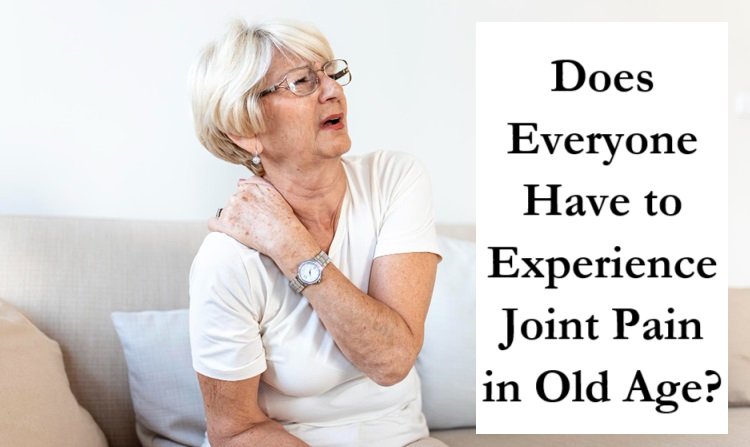Whether joint pain is going to be part of your old age depends on several factors. Your lifestyle, weight, health condition, bone quality, dietary quality, level of activity, etc—everything has a say!
Yet, in general, some level of joint pain might be everyone’s experience from time to time in old age. It is so because our body sustains wear and tear as we age. Most of our body parts become fragile naturally, leading to low stamina.
However, chronic and intense joint pain isn’t only a common old-age experience. People with arthritis or internal health problems have such long-lasting joint pain.
Let’s explore joint pain, the causes of joint pain and whether joint pain will be a part of your old age, along with other crucial aspects.
What Is Joint Pain?
A joint is a place in the musculoskeletal system where two or more bones come together. Such points are technically called articulations. Joints help us mobilise our entire body in multiple ways. They are the basis of our physical motion.
Furthermore, a joint isn’t just a place where the bone ends meet. Instead, there are various soft-tissue structures as well. These are tendons, ligaments, bursae, synovium, muscles, nerves, articular cartilage, etc.
So, when any of these structures—whether soft or hard—gets damaged, one experiences pain in the joint. Damage can happen as a result of an injury, overuse or an internal condition like an autoimmune disorder.
Does Everyone Have to Experience Joint Pain In Old Age?
There are two types of joint pain, namely, occasional and chronic. So, although occasional joint pain might be a common old-age experience, chronic pain only occurs due to arthritis or other health issues.
Causes
Chronic joint pain in old age could be due to the following reasons.
Osteoarthritis: Damage to articular cartilage, soft tissue over bone ends, results in joint stiffness, pain and mobility issues. The condition is often known as osteoarthritis.
Many people with severe hip osteoarthritis need a joint replacement. To learn about the recovery time, visit the following link: hip replacement surgery recovery time.
Rheumatoid Arthritis: It is an autoimmune disorder that causes polyarticular joint inflammation (affecting more than one joint). RA restricts mobility severely in old age. It results in poor quality of life and depressive mental health.
Lupus: It is another chronic autoimmune disease like rheumatoid arthritis. Under an autoimmune disorder, the body’s immune system attacks healthy cells within the body. Lupus is such a condition where our immune system gets corrupted and starts attacking its own healthy tissue and organs.
Gout: It is a form of arthritis. It occurs due to the urate crystals accumulating in joints. This condition results in intense pain and inflammation! The pain is often known as a gout attack.
Septic Arthritis: A direct infection in the joint cavity also leads to joint pain. The bacterial infection in a joint is known as septic arthritis.
Reactive Arthritis: Sometimes, infection in one part can cause pain or inflammation in joints remotely situated. This is reactive arthritis. Here, the infection isn’t in the joint but somewhere else.
Injury: An injury can also give rise to arthritic symptoms, commonly known as post-traumatic arthritis.
Chronic Fatigue Syndrome: This is a condition where the affected person experiences too much fatigue that might last as long as 6 months once occurred. The cause is unknown. Often, the symptoms flare with physical and mental activities and even rest and proper sleep doesn’t seem to be making the situation any better.
Infections: Viral fever and other types of infections can also cause joint pain.
These are the major causes of chronic joint pain if not treated well. If any of these conditions occur to you in old age, you will experience lasting joint pain.
There is one more condition as well that can cause joint pain in old age. However, this condition only causes temporary joint pain that typically goes away with enough rest and sleep.
Overuse Syndrome: The body of an old person is already weak and fragile. Thus, working beyond capacity or overworking will lead to muscle and joint pain without a doubt. This condition is called overuse syndrome.
Please, note that the list of causes of joint pain above isn’t exhaustive.
Diagnosis
The following tests can be used by a joint specialist to confirm an exact diagnosis.
X-ray: This helps find out what is wrong with joint bones and other bones in our body’s skeletal system.
Ultrasound: This test is used to examine internal soft tissue structures within the body. However, it doesn’t work for body parts deep underneath the skin.
MRI: An MRI test can make images of soft tissue as well as bony parts. It also gives a detailed analysis of the structures deep within the skin, unlike an ultrasound test. However, there is one restriction. This technique of diagnosis cannot be used with a patient who already has metal implant components inside the body.
CT Scan: A CT scan can be used even on patients with metal implants within the body. This test produces detailed images of both soft tissue and bones. And, it doesn’t matter how deep a part is within the body. CT scans offer in-depth imaging experiences.
Blood Tests: If an imaging test shows the signs of tumours or cancer, blood tests can also be recommended. It will help confirm a variety of conditions regarding a tumour.
Biopsy: After a tumour has been confirmed, a biopsy might also be required for the close inspection for the presence of cancerous cells.
All these tests help ensure the accuracy of diagnosis so that the most suitable and effective treatment can be administered!
Treatment Options
Joint pain can be treated or managed in multiple ways. Mostly, the treatment options you need depend on the nature of the diagnosis.
Rest: For overuse syndrome, rest and adequate sleep is the solution.
Physiotherapy: This therapy is used to manage a variety of arthritic symptoms. Physiotherapy helps alleviate pain, improve mobility and improve the quality of life. A physiotherapist also helps learn about the right way of living to reduce pain and promote mobility and physical comfort.
Medications: Painkillers might also be recommended in case the joint pain is intense and extremely debilitating. Medications don’t have to be always oral as they could also be injectable (corticosteroid injections) or topical (in a gel-like consistency).
Surgery: A surgical intervention can also be required. A damaged joint might require a total joint replacement. However, if the damage does not affect the entire joint, partial arthroplasty might also be recommended by a joint specialist.
If you need to consult a hip replacement surgeon, access the following link: best hip replacement doctors in India.
Conclusion
Not everyone has to face joint pain in old age. It depends on the overall health and other factors as outlined in the very beginning.
Yet, in old age, everyone’s body is weak. Thus, occasional joint pain might be inevitable. However, chronic joint pain only occurs as a result of a chronic illness. Some of these conditions are mentioned above.
For joint pain, whether in old age or adulthood, one must always consult an orthopedic doctor for the most accurate diagnosis and suitable treatment. Don’t ignore the condition.




